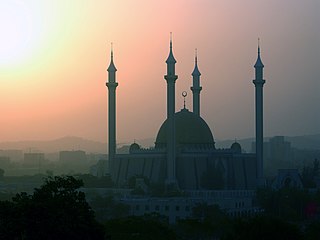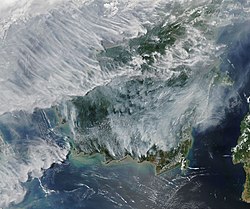
Sumatra is one of the Sunda Islands of western Indonesia. It is the largest island that is fully within Indonesian territory, as well as the sixth-largest island in the world at 482,286.55 km2 (182,812 mi.2), including adjacent islands such as the Simeulue, Nias, Mentawai, Enggano, Riau Islands, Bangka Belitung and Krakatoa archipelago.

Southeast Asia is the geographical southeastern region of Asia, consisting of the regions that are situated south of China, east of the Indian subcontinent, and northwest of the Australian mainland, which is part of Oceania. Southeast Asia is bordered to the north by East Asia, to the west by South Asia and the Bay of Bengal, to the east by Oceania and the Pacific Ocean, and to the south by Australia and the Indian Ocean. Apart from the British Indian Ocean Territory and two out of 26 atolls of the Maldives in South Asia, Maritime Southeast Asia is the only other subregion of Asia that lies partly within the Southern Hemisphere. Mainland Southeast Asia is entirely in the Northern Hemisphere. East Timor and the southern portion of Indonesia are the parts of Southeast Asia that lie south of the equator.

The Strait of Malacca is a narrow stretch of water, 800 kilometres (500 mi) long and from 65 to 250 km wide, between the Malay Peninsula to the northeast and the Indonesian island of Sumatra to the southwest, connecting the Andaman Sea and the South China Sea. As the main shipping channel between the Indian and Pacific oceans, it is one of the most important shipping lanes in the world.

Haze is traditionally an atmospheric phenomenon in which dust, smoke, and other dry particulates suspended in air obscure visibility and the clarity of the sky. The World Meteorological Organization manual of codes includes a classification of particulates causing horizontal obscuration into categories of fog, ice fog, steam fog, mist, haze, smoke, volcanic ash, dust, sand, and snow. Sources for particles that cause haze include farming, traffic, industry, windy weather, volcanic activity and wildfires. Seen from afar and depending on the direction of view with respect to the Sun, haze may appear brownish or bluish, while mist tends to be bluish grey instead. Whereas haze often is considered a phenomenon occurring in dry air, mist formation is a phenomenon in saturated, humid air. However, haze particles may act as condensation nuclei that leads to the subsequent vapor condensation and formation of mist droplets; such forms of haze are known as "wet haze".

The ASEAN Agreement on Transboundary Haze Pollution is a legally binding environmental agreement signed in 2002 by the member states of the Association of Southeast Asian Nations to reduce haze pollution in Southeast Asia. The Agreement recognises that transboundary haze pollution which results from land and/or forest fires should be mitigated through concerted national efforts and international co-operation.

The 2006 Southeast Asian haze was an air pollution event caused by continuous, uncontrolled burning from "slash and burn" cultivation in Indonesia, which affected several countries in the Southeast Asian region and beyond, including Malaysia, Singapore, southern Thailand, and as far away as Saipan; the effects of the haze may have even spread to South Korea. Local sources of industrial pollution also, inadvertently, contributed to increases in air toxicity ; notably at-risk areas included communities close to textile factories, fertilizer plants, meat-packing plants, industrialised dairy farms, shipping ports, and oil refineries. Air quality was lower, overall, for residents of more densely-populated cities. In the highly urban and industrialised Klang Valley of Malaysia, in particular, the surrounding elevated terrain acted as a natural retainer of polluted air, aggravating the situation as the haze set in.

The Pollutant Standards Index (PSI) is a type of air quality index used in Singapore, which is a number used to indicate the level of pollutants in air. Initially PSI was based on five air pollutants, but since 1 April 2014 it has also included fine particulate matter (PM2.5).

The 1997 Southeast Asian haze was an international air pollution disaster that occurred during the second half of 1997, its after-effects causing widespread atmospheric visibility and health problems within Southeast Asia. Considered the most severe Southeast Asian haze event of all time, the total costs of the 1997 haze are estimated at US$9 billion, due mainly to health care and disruption of air travel and business activities.

The Southeast Asian haze is a fire-related recurrent transboundary air pollution issue. Haze events, where air quality reaches hazardous levels due to high concentrations of airborne particulate matter from burning biomass, have caused adverse health, environmental and economic impacts in several countries in Southeast Asia. Caused primarily by slash-and-burn land clearing, the problem flares up every dry season to varying degrees and generally is worst between July and October and during El Niño events. Transboundary haze in Southeast Asia has been recorded since 1972 with the 1997 and 2015 events being particularly severe.

The 1997 group of forest fires in Indonesia that lasted well into 1998 were probably among the two or three, if not the largest, forest fires group in the last two centuries of recorded history.

The 2009 Southeast Asian haze was an episode of large scale air pollution primarily caused by slash and burn practices used to clear land for agricultural purposes in Sumatra, Indonesia. It affected the areas surrounding the Straits of Malacca which besides Indonesia include Malaysia and Singapore.

Air pollution has been an ongoing problem in many countries in the Southeast Asia region, and Malaysia is one of the worst affected. Haze has been a major issue for the country, driven by slash and burn practices by farmers and peat fires blown by the wind from Indonesia.

Indonesia and Singapore established diplomatic relations on 7 September 1967, a month after the formation of the Association of Southeast Asian Nations (ASEAN) on 8 August 1967. Indonesia and Singapore are two of the five founding members of ASEAN. Both nations are also members of the Non-Aligned Movement and APEC.

The 2013 Southeast Asian haze was a haze crisis that affected several countries in Southeast Asia, including Brunei, Indonesia, Malaysia, Singapore and Southern Thailand, mainly during June and July 2013. The haze period was caused by large-scale burning in many parts of Sumatra and Borneo. Satellite imagery from NASA's Terra and Aqua satellites showed that the haze was mainly due to smoke from fires burning in Riau province, Indonesia.

The 2015 Southeast Asian haze was an air pollution crisis affecting several countries in Southeast Asia, including Brunei, Indonesia, Malaysia, Singapore, southern Thailand, Vietnam, Cambodia and the Philippines.
Golden-Agri Resources (GAR) is a Singaporean palm oil company, listed on the Singapore Stock Exchange since 1999. In May 2015, its market capitalization was $4.1 billion. Franky Widjaja, of the Sinar Mas family is its CEO. Alnoor is a subsidiary of GAR. Lew Syn Pau used to serve as a member of the Singaporean Parliament for 13 years and is a member of the board of directors of the firm.

The 2016 Southeast Asian Haze was a transnational haze crisis which is a recurring problem with transboundary air pollution brought on by fires. The 2016 haze that took place affected several countries in Southeast Asia, including Indonesia, Malaysia and Singapore. It brought negative effects towards the environment and brought an impact on people's health and the economy.

People's Movement to Stop Haze (PM.Haze) is a non-governmental organisation based in Singapore. It was founded in 2014 in response to the 2013 Southeast Asian haze, which has been recognised as one of the most serious haze episodes in over 16 years. PM.Haze started its work with an investigative research project to fire-prone areas in Riau Province, Indonesia and identified peatland degradation due to mismanagement of concession lands by irresponsible companies as the fundamental cause of the fires in the areas and the resulting transboundary haze pollution. In 2016, it became registered as a society. In 2017, it underwent a rebranding exercise and adopted a new logo to symbolise a constant flow for fresh, clean air with an arrow pointed upward to represent constructive action towards this. PM.Haze was mentioned by Minister for the Environment and Water Resources Masagos Zulkifli as he delivered Singapore's national statement at the United Nations Environment Assembly in Nairobi in December 2017.

The 2010 Southeast Asian haze was an air pollution crisis that affected many Southeast Asian countries such as Indonesia, Malaysia and Singapore during October 2010.

A trans-national air pollution crisis affected several countries in Southeast Asia from February to September 2019, including Brunei, Indonesia, Malaysia, the Philippines, Singapore, Thailand, and Vietnam.











